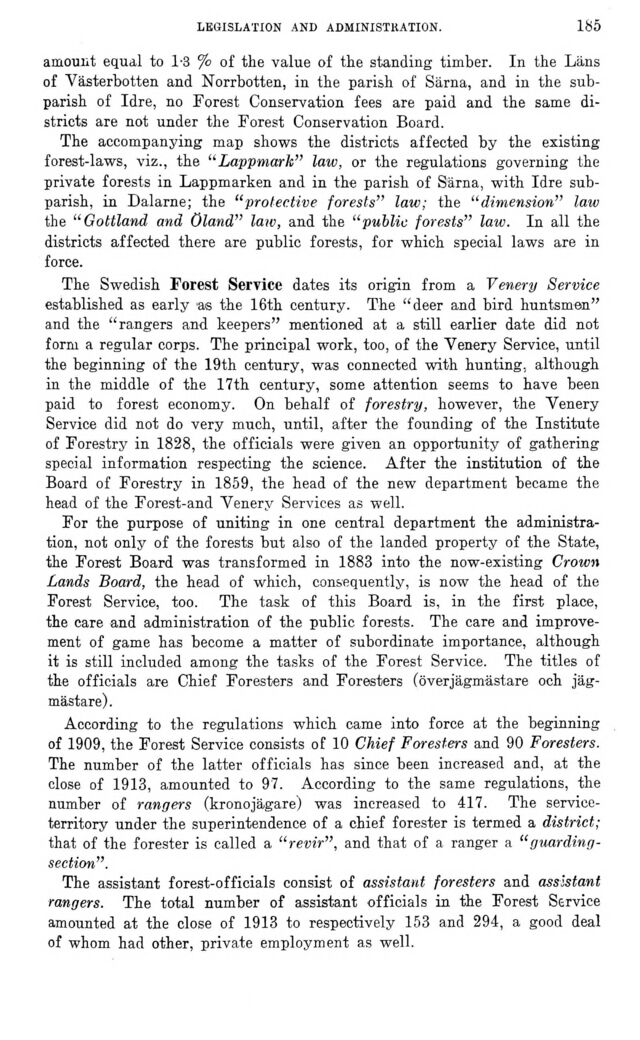
Full resolution (JPEG) - On this page / på denna sida - IV. Forestry - 1. Forests. By Th. Örtenblad

<< prev. page << föreg. sida << >> nästa sida >> next page >>
Below is the raw OCR text
from the above scanned image.
Do you see an error? Proofread the page now!
Här nedan syns maskintolkade texten från faksimilbilden ovan.
Ser du något fel? Korrekturläs sidan nu!
This page has never been proofread. / Denna sida har aldrig korrekturlästs.
legislation and administration.
185
amount equal to 1-3 °/o of the value of the standing timber. In the Läns
of Västerbotten and Norrbotten, in the parish of Särna, and in the
sub-parish of Idre, no Forest Conservation fees are paid and the same
districts are not under the Forest Conservation Board.
The accompanjdng map shows the districts affected by the existing
forest-laws, viz., the "Lappmark" law, or the regulations governing the
private forests in Lappmarken and in the parish of Särna, with Idre
sub-parish, in Dalarne; the "protective forests" law; the "dimension" law
the "Gottland and Öland" law, and the "public forests" law. In all the
districts affected there are public forests, for which special laws are in
force.
The Swedish Forest Service dates its origin from a Venery Service
established as early as the 16th century. The "deer and bird huntsmen"
and the "rangers and keepers" mentioned at a still earlier date did not
form a regular corps. The principal work, too, of the Venery Service, until
the beginning of the 19th century, was connected with hunting, although
in the middle of the 17th century, some attention seems to have been
paid to forest economy. On behalf of forestry, however, the Venery
Service did not do very much, until, after the founding of the Institute
of Forestry in 1828, the officials were given an opportunity of gathering
special information respecting the science. After the institution of the
Board of Forestry in 1859, the head of the new department became the
head of the Forest-and Venery Services as well.
For the purpose of uniting in one central department the
administration, not only of the forests but also of the landed property of the State,
the Forest Board was transformed in 1883 into the now-existing Crown
Lands Board, the head of which, consequently, is now the head of the
Forest Service, too. The task of this Board is, in the first place,
the care and administration of the public forests. The care and
improvement of game has become a matter of subordinate importance, although
it is still included among the tasks of the Forest Service. The titles of
the officials are Chief Foresters and Foresters (överjägmästare och
jägmästare).
According to the regulations which came into force at the beginning
of 1909, the Forest Service consists of 10 Chief Foresters and 90 Foresters.
The number of the latter officials has since been increased and, at the
close of 1913, amounted to 97. According to the same regulations, the
number of rangers (kronojägare) was increased to 417. The
service-territory under the superintendence of a chief forester is termed a district;
that of the forester is called a "revir", and that of a ranger a "guarding•
section".
The assistant forest-officials consist of assistant foresters and assistant
rangers. The total number of assistant officials in the Forest Service
amounted at the close of 1913 to respectively 153 and 294, a good deal
of whom had other, private employment as well.
<< prev. page << föreg. sida << >> nästa sida >> next page >>